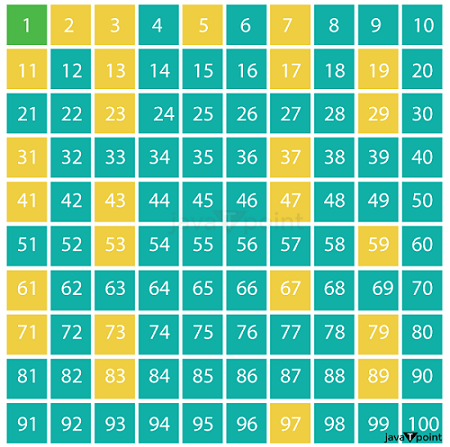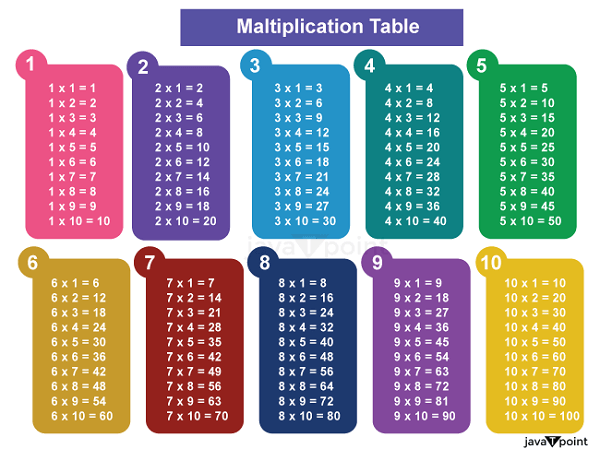Tables from 1 to 10The tables from 1 to 10 refer to the multiplication tables that show the products of numbers from 1 to 10 when multiplied together. These tables are fundamental in mathematics education and play a crucial role in developing numerical fluency and problem-solving skills. 
Table 1:1 x 1 = 1 Table 2:2 x 1 = 2 Table 3:3 x 1 = 3 Table 4:4 x 1 = 4 Table 5:5 x 1 = 5 Table 6:6 x 1 = 6 Table 7:7 x 1 = 7 Table 8:8 x 1 = 8 Table 9:9 x 1 = 9 Table 10:10 x 1 = 10 These tables provide a systematic representation of multiplication facts and are widely used in educational settings to aid in the learning and memorization of multiplication facts. They serve as a foundation for more advanced mathematical concepts and calculations. 
How to Remember Tables From 1 to 10?It might be difficult to remember the multiplication tables from 1 to 10, but with certain useful techniques and repetition, it gets simpler. The following methods will aid you in remembering the tables: 1. Understanding the Patterns: Recognize the links and patterns seen in the tables. For instance, each product in the table of two is double what it was before. Memorization can be facilitated by an understanding of these patterns. 2. Use Visualization Techniques: Use visualization techniques to help you visualize the multiplication facts. Think about three groups of four things, for instance, while multiplying 3 by 4. Then, add up the total. Adding images to information can help people remember them for longer. 3.Break Things Down: Separate the tables into manageable portions then try to learn all the tables at once, concentrate on learning just one. Start with the simpler tables, such as 1, 2, 5, and 10, then progress to the more difficult ones gradually. 4.Learn with Songs or Rhymes: Use songs or rhymes as mnemonic techniques to help you recall the multiplication facts. Numerous educational materials include memorable songs or rhymes to aid with memorizing. Learning may be fun and interesting by singing along or repeating the rhymes. 5.Practice Regularly: Regular practice is necessary for memorization of the tables. Schedule time specifically each day to go through and practice the multiplication facts. To frequently practice the tables, use flashcards, online tests, or interactive learning resources. 6.Apply the Facts: Use your knowledge of multiplication to solve problems or in everyday life. The active use of the tables emphasizes the usefulness of multiplication and aids with memory retention. 7.Use Online Resources and Educational Apps: Use online tools and software to help you learn the multiplication tables. Learning is fun and interactive because of the abundance of interactive games, tests, and lessons accessible. 8.Visual Aids: Make your own charts or posters for multiplication, for example, and put them up in your study space. These visible cues can act as brief reminders and help with remembering. 9.Teach Someone Else: Throughout the learning process, practice patience with yourself and positivity. It takes time and effort to memorise the tables, but you may succeed if you are persistent and have a good mindset. 10.Be Patient and Positive: Throughout the learning process, practice patience with yourself and positivity. It takes time and effort to memorise the tables, but you may succeed if you are persistent and have a good mindset. Importance of Tables from 1 to 10 The tables from 1 to 10 are extremely valuable and offer many advantages in mathematics instruction. Let's examine these tables' significance: 1.Mastering Multiplication The basis for comprehending and mastering multiplication is provided by the tables from 1 to 10. They give pupils a methodical way to describe multiplication facts and assist them in understanding repeated addition and the connection between factors and products. 2.Mathematical fluency is improved by memorizing multiplication tables People are better able to conduct computations mentally if they can quickly recall multiplication facts. This breadth of fluency allows for quicker mathematical thinking and problem-solving in various areas of mathematics. 3.Calculation Efficiency: Having a solid understanding of the tables from 1 to 10 enables people to complete calculations more quickly and easily. Knowing multiplication facts allows for quicker computations and more effective problem-solving in arithmetic, quantity estimation, and mathematical connections. 4.Mental Math Skills: The capacity to make calculations in one's head is a useful one in daily life. Understanding multiplication tables helps people to mentally calculate and estimate amounts, which makes jobs like grocery shopping, cooking, and budgeting easier. Through the use of these tables, one may develop their general number sense and mathematical agility. 5.Problem-Solving Skills: Knowing the multiplication tables increases problem-solving skills. When presented with mathematical difficulties or real-life circumstances involving multiplication, individuals can use the tables to design more effective techniques and solutions. This ability goes beyond mathematics to include problem-solving in a variety of domains. Uses of Tables from 1 to 10 to Solve ProblemsExample 1: A client regularly purchases four apples. In 4 days, how many apples will the client purchase? Solution:Each day, the consumer purchases 4 apples. As a result, using the math tables from 1 to 10, the buyer purchased a total of 16 apples over the course of 4 days. Example 2:Janice jogs three kilometers every day. Use the tables from 1 to 10 to calculate how many kilometers she jogs in 9 days. Solution:Janice jogs three kilometers every day. As a result, the total distance travelled after 9 days is 3 * 9 = 27 miles. Example 3:Every day, Doris bakes three cookies. In a week, how many cookies does she produce? Solution:Every day, Doris bakes three cookies. The total number of cookies created after seven days, calculated using tables 2 through 10, is three times seven, or 21 cookies.
Next TopicWhat is 0 divided by 0
|
 For Videos Join Our Youtube Channel: Join Now
For Videos Join Our Youtube Channel: Join Now
Feedback
- Send your Feedback to [email protected]
Help Others, Please Share










